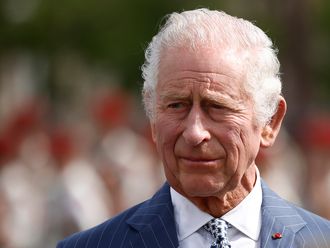Athens: Call it “CSI: Alexander.” For months, the excavations at a large, ancient tomb in northern Greece have gripped the country. First, a marble slab wall was unearthed. Then, through announcements and leaks from the Greek Culture Ministry meted out with the pacing of a good mystery series, the public learnt of headless sphinxes and other statues. Finally, bones! But whose?
Is it possible — as culture officials implied with a wink and a nod, but never actually stated — that the tomb could be for the family of Alexander the Great? Archaeologists say it’s highly unlikely. But that’s hardly the point. By the time the Culture Ministry announced this week that the bones of five people, not one, had been found in the tomb, it was the latest episode in an archaeological reality show that has entertained Greeks and distracted them from their economic troubles.
The show has also starred Prime Minister Antonis Samaras. Even before he found himself fighting for political survival in national elections, Samaras used the excavation in Amphipolis, in the Greek region of Macedonia, to tap into national pride. He made a televised visit to the tomb in August — widely seen as an evocation of Alexander’s legacy — and later showed Chancellor Angela Merkel of Germany artefacts found at the site. This week, Samaras, whose conservative New Democracy party was trailing the leftist Syriza Party in a close race, mentioned Amphipolis in a campaign speech, calling Macedonia “the eternal bastion of Greece.”
“It’s a kind of positing of national pride, but also nationalist connotations and feelings,” said Yannis Hamilakis, a professor of archaeology at the University of Southampton, in England, and the author of “The Nation and Its Ruins: Antiquity, Archaeology, and National Imagination in Greece.” Conjuring up Alexander the Great — “his assumed civilising campaigns, his conquest of the Orient” — emphasises his place in “the Western imagination as a whole,” Hamilakis said.
While acknowledging that the tomb is a significant find that deserves public enthusiasm, Hamilakis and other archaeologists argue that the dig has been conducted hastily and in a way that places popular appeal over serious scholarship. The Greek media have thrived on the story — a rare bright spot in a cycle dominated by austerity and unemployment. Archaeology buffs have taken to the blogosphere, floating their own theories. Last year, “Amphipolis” was the most popular search term on Google in Greece.
Busloads of tourists have flocked to the site but can view it only from afar because the Culture Ministry has blocked access. The ministry also declined to allow Aikaterini Peristeri, the lead archaeologist on the dig, to be interviewed. (As elections neared, a recent cartoon in the Greek press showed Samaras lifting up Peristeri, whose last name means dove in Greek, as if she were a peace offering.)
The mound where the tomb was discovered lies in the ancient city of Amphipolis, about 200 miles north of Athens. Archaeologists began excavating the site in the 1960s. After a new dig started in 2012, archaeologists unearthed a 9-foot-high marble slab that would later prove to be part of a wall 1,600 feet in perimeter enclosing the tomb. The Culture Ministry dates the wall to the fourth century BC.
But the dig really picked up in June, and archaeologists eventually discovered two headless sphinxes at the tomb’s entrance, “an impressive and unique feature not previously encountered in Macedonian tombs,” Anna Panagiotarea, a spokeswoman for the Culture Ministry, wrote in response to questions. This “understandably generated great interest, excitement, enthusiasm and expectations among scientists, the media and the public alike,” she added.
The Alexander factor emerged in August, when Samaras visited the site and his culture and sports minister, Konstantinos Tasoulas, made elliptical comments about how Greece had been waiting 2,300 years for the tomb to be discovered — an implicit reference to the era of Alexander the Great, who in the fourth century BC was tutored by Aristotle and built up a vast empire before dying in Babylon.
Last fall, archaeologists said they had found three vaulted chambers behind the facade decorated with the sphinxes, as well as a mosaic depicting the abduction of Persephone by Hades and two female statues known as caryatids, each 7 feet tall.
On Monday, months after announcing that bones had been found, the Culture Ministry said the fragments belonged to at least five bodies — two men ages 35 to 45, a woman over the age of 60, an infant and a fifth body whose bone fragments showed signs of cremation. One of the men’s bones had cut marks, possibly indicating wounds by a sharp object. The ministry said it would conduct DNA exams to see if there were family links between the bodies.
Although the official news release said nothing about Alexander the Great, a report on Monday in the Athens daily Kathimerini cited vague sources at the Culture Ministry saying that the female skeleton might be Olympias, Alexander’s mother, who was murdered after his death. The article first appeared under the headline “Amphipolis Scientists Point to Olympias” but was later revised to read “Skeletons Pose Many Questions.”
Archaeologists have said it is more likely that Olympias was buried alone, and they cite multiple inscriptions that place her burial site in the city of Pydna, in northern Greece. They also say there is no evidence that the tomb was that of Alexander the Great or his family. “No, we don’t believe it is,” said Olga Sakali, the president of the Association of Greek Archaeologists. “All the historical sources that we have until now don’t give us such a clue.”
The association filed a formal complaint to the Culture Ministry protesting about the timing and methodology of the dig, which the association says bypassed normal methods. They were aghast that mechanical earth-moving equipment was used, instead of more delicate means. “It was an excavation for the media,” Sakali said.
In a statement, the Culture Ministry said that the earth-moving equipment was “restricted to the early stages of the excavation,” at which point “expert staff” took over and “followed all established scientific methodologies, protocols and etiquette to the fullest.” The ministry said the dig had not been “hasty, archaeologically ‘unorthodox’ or scientifically improper.”
Regardless of the debate, many have just enjoyed the ride. “It’s great material,” said Antonis Kanakis, the host of Radio Arvyla, a comedy program on Greek television, who “interviewed” a skeleton in a popular sketch last fall. Kanakis quoted one of his subject’s answers: “OK, you’re very proud of your ancestors, but have you asked your ancestors if they’re proud of you?”












